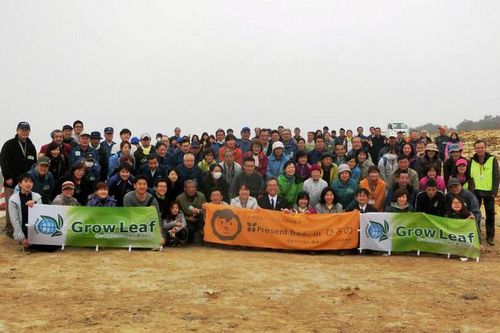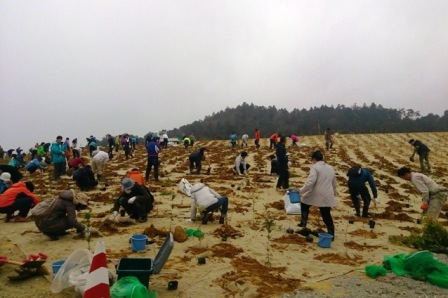June 27, 2016
Tree Planting Initiative in Disaster-Affected Town
Keywords: Disaster Prevention / Reduction Disaster Reconstruction Ecosystems / Biodiversity

Copyright NPO Environmental Relations All Rights Reserved.
On March 6, 2016, nearly five years after the Great East Japan Earthquake, the disaster-struck town of Hirono, located in Futaba District, Fukushima Prefecture, held its first networking event for its Present Tree initiative. In this article we introduce the initiative, which seeks to revitalize the town by creating opportunities for exchange between Hirono residents and companies and residents from urban areas.
Approximately 130 people participated in the event, including Hirono locals, nearby cooperative organizations, and bus tourists from Tokyo. The participants planted about 2,000 seedlings of broadleaf species native to Fukushima prefecture (Castanopsis sieboldii, Japanese evergreen oak, saw tooth oak, konara oak, Japanese hackberry).
The trees were planted on a raised embankment created as a disaster buffer zone. Due to the area's clay-like soil, holes had to be dug to add fertilizers so that the seedlings could grow into healthy trees. Adding the fertilizers turned out to be as exhausting as digging the holes, but the participants united around the work with single-minded devotion.

Copyright NPO Environmental Relations All Rights Reserved.
After the trees were planted, Hirono mayor Satoshi Endo expressed his enthusiasm about the town's ongoing recovery. The participants then deepened their camaraderie over lunch, a delightful cuisine made from local produce and paired with a local junmai sake (sake made without added alcohol or sugar). The sake, released in February in 2016 for the first time, is brewed from local Koshihikari-brand rice and sold by a committee in Hirono to promote the town's history, culture, and agricultural products to visitors.
In the afternoon, a bus party from Tokyo started on a study tour of the affected area. They visited Tomioka Town while accompanied by Ms. Minako Tanaka, a local disaster storyteller and one of the many people who had been forced to evacuate the town because of high radiation levels. Tanaka now lives in the city of Iwaki.

Copyright NPO Environmental Relations All Rights Reserved.
Tanaka says that the disaster recovery has made gradual progress in terms of infrastructure and buildings, but she feels that people's hearts are being left behind. Many have had difficulty adjusting to the prolonged wait in their new communities, where they tend not to know anyone.
Meanwhile, many children and younger generations have gotten used to school life in their new towns, with very few coming back to their hometown after the evacuation directive was lifted. Most who do come back are elderly people. Those who had been on close terms with their neighbors find the situation at home difficult to bear, as they now have no one to talk with.
For these reasons, Present Tree in Hirono is promoting the recovery of Hirono Town and the creation of the new Futaba area. Through various projects it is working to breathe life back into the town by educating urbanites, the "foster parents" of the planted trees, about current conditions in affected areas, and by creating opportunities for their social exchange with local residents.
Related
"JFS Newsletter"
- Aiming to Build New Communities in Earthquake-Stricken Areas: Ishinomaki Jichiren's Initiatives
- Investment to Help Disaster-affected Areas -- Initiative of Disaster Area Support Funds Initiative
- Disaster-Affected Ishinomaki -- Present Status (Part 2)
- Disaster-Affected Ishinomaki -- Present Status (Part 1)
- Tohoku and the World: 5 Years Since The Great East Japan Earthquake and Tsunami


